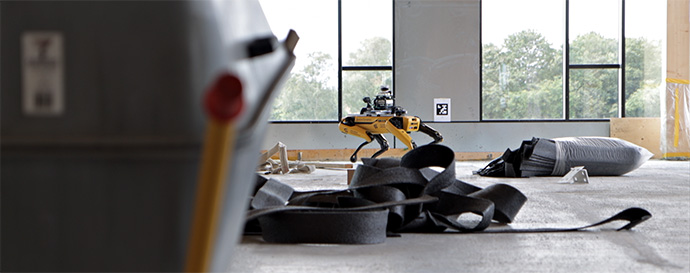In search of the construction site robot of the future
Several robot companies and partners in construction have spent the last year exploring, developing, and learning more about future construction site robots, which, according to the Danish Technological Institute (DTI), have two crucial characteristics.
The construction industry has an excess of heavy, noisy, and dusty tasks.
DTI and Aalborg University have therefore – together with many robot companies and partners in construction – worked to push the limits of how robots can help in the construction industry. They have done that in the Odense Robotics project DEFTNESS.
- Construction sites are a particularly complex and changeable environment that places great demands on robot technology, which typically thrives best in defined and familiar surroundings. In this project, we have tried to explore what can be done with the latest robot technology, as well as learn more about what is needed to lower the barriers for more robots on construction sites, says Tsampikos Kounalakis, who is a Product Manager at the Danish Technological Institute.

Are we following the construction plan?
One of the ways of using robots in construction today is to follow and verify the progress of the build. This was verified through testing with two different mobile robots with the same set of sensors, concluding speed, payload, flexibility, obstacle avoidance, and more.
- Robots in construction today are essential to monitor and validate the progress of projects. They must be able to safely navigate dynamic and unpredictable environments, often in collaboration with people. It is essential that these robots can autonomously identify and follow safe paths and actions by the tasks programmed by humans, explains Shahab Heshmati Alamdari, who is an Associate Professor from Aalborg University.
In addition, the project developed and demonstrated drone-based quality verification via inspection of building elements on a construction site.
Reducing tiring tasks
One of the partners in the project is the construction company NCC, which sees great potential for robotic technology.
- We are interested in reducing the heavy, noisy, and dusty work tasks for our employees as much as possible, says Peter Kirkegaard, who is a working environment consultant and coordinator of major construction projects at NCC.
- Currently, a person must, for example, manually sand a newly poured cement floor with a machine. It is hard and dusty work. – so why not automate it? Then the sanding could be carried out in the evening when there are no others on the construction site, he adds.
NCC also sees potential for automation when it comes to transporting materials about the site, assembly, waste collection, and waste handling.
A construction site robot's two defining characteristics
Although there are already robot technologies ready to help in construction, there is still development work ahead before widespread adoption in the industry is seen.
- If we look to the future, two things in particular will be decisive when construction sites begin to embrace robotic technology to a greater extent. Firstly, robots must become even better at interacting with not only the changing environment of construction sites but also people and building materials. Secondly, it must be even easier than today to set up the robot and press start, emphasises Tsampikos Kounalakis from DTI.
Peter Kirkegaard adds that, for the contracting companies and their employees, it must also be possible to see a financial gain in, for example, putting a sanding robot to work instead of a construction worker.
The partners in the DEFTNESS project consist of Capra Robotics, Hecto Drone, Meili Robots, NCC, Roico, Site-Tech, Aalborg University, and DTI.
The project is carried out under the auspices of Odense Robotics, which is co-financed by the Danish Board of Business Development, the Danish Agency for Higher Education and Science, and the European Union.